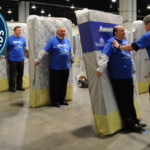During a professional development training around employee engagement, a woman came up to me during a break. In a very quiet voice, said that she wanted to share with the group why she loves her job, but felt embarrassed to do so in front of everyone because she thought it was silly.
So I asked her what drove her job satisfaction, to which she replied, “I love this job because of the liberal holiday policy.”
At first, we both laughed, but then I asked a few follow-up questions about why she loves the policy. She went into a deep story about her childhood. Her dad was gone all the time as a truck driver and her mom worked retail, which meant she worked almost every holiday. In the middle of her reflection, an epiphany sparked in her brain. She realized that the reason she loves the liberal holiday policy of her job is because as a child, she didn’t have holidays. Now as an adult, with a family, she cherishes her holidays. This is why it would be a great idea for many small business owners to keep a track of federal holidays. This list of federal holidays in 2020 can keep you up to date on where the federal government stands on holidays.
The holiday policy is the reason she loves her job. And because she loves her job, she is, according to Gallup, a highly engaged employee. Since she is a highly engaged employee, she isn’t planning to leave her job any time soon (assuming other factors of her job are positive). Win – Win – Win. This is maybe more important for the business than you think. A Together report on employee turnover is a truly fascinating read and might be able to provide you with some more insight on why this is so important. Those who are not engaged are more likely to leave the business and be less productive, so it really is vital that a business engages its employees. There are numerous employee engagement programs that can be implemented in businesses, creating a stronger link between employees and their job role, which in turn improves productivity.
Psychologist Frederick Herzberg is famous for studying employee motivation and introduced the “Two-Factor Theory” around employee motivation. The two factors of employee motivation are:
Hygienic – Factors that are considered standard elements of a job. Job security, salary, fringe benefits, work conditions, good pay, paid insurance, and vacation policies all fall into this bucket.
Intrinsic – Factors related to a person’s intrinsic motivations. These include: having challenging work, achievement recognition, responsibility, opportunity to do something meaningful, involvement in decision making, sense of importance to an organization, life goals, and personal growth. Giving employee appreciation is a great way of celebrating achievement.
Through his research, Herzberg found that hygienic factors only have a limited capacity to influence an employee’s motivation. Intrinsic factors, meanwhile, can have an unlimited influence on an employee’s motivation. The issue for employers, however, is that while hygienic factors can be uniform across the team and organization, intrinsic factors are very specific to each employee and team member. One size does not fit all.
According to a Deloitte survey, 43% of Millennials plan to quit their current job within two years. Further, only 28% plan to stay in their current role for more than five years. Yikes! What do we do about this high rate of millennial employee turnover?
If you lead a team or organization with younger members, you better be paying attention to each employee’s intrinsic factors for motivation.
If you aren’t, you might face the consequences of the cost of millennial employee turnover, which is reported to be as high as 30% of the annual salary of that employee.
Here are three creative policies you can use to better tap into an employee’s intrinsic factors for motivation:
1) Encourage The Side Hustle
Google allows its employees to use up to 20% of their time on side hustles. Gore-Tex gives its employees 10% of time. In both cases, the companies are allowing their employees to explore ideas that excite them, while also leading to some amazing breakthrough products for the companies, such as Gmail.
2) Make Caring Part Of The Culture
A core value of Swift Kick is “Open Doors, Open Hearts” which means that through openness comes trust, respect, and growth. During our weekly one-on-one meetings, there is a section around this core value when every employee knows they will have an opportunity to share what’s on their mind and in their heart. The simple notion of letting them know they have this space and ability to share makes caring a part of our culture. The work gets done, we just have to remember that it’s humans doing the work. As I said in my TEDx Talk, humans are just walking cucumbers with anxiety.
The idea of caring should also extend to your greater community and the world as a whole. Millennials want to know that you are not just interested in profits.
3) Focus on Results, Not Hours
Have you ever packed for a trip before? When does the majority of the packing happen? If you are like most people, it happens within the last few hours before leaving for the airport. How much gets done in an hour depends on a person’s motivation to get it done. The same is true at work. The 9-5 work day is a made up concept, and yet is a standard for so many work places. When in reality, what matters more than putting in the hours is what gets done during those hours. Give your millennials space to make hours that allow them to get all their work done, while also the ability to leave early or come in late if needed. Holding them to strict hours will make them feel caged.
Millennials are quickly becoming the largest percentage of the workforce. In doing so, they are reshaping the old rules of employee motivation, and organizational culture. It’s easy to dismiss everything I just wrote above as nonsense and tell millennials to toughen up. I’ll warn you again that in doing so, you might face the consequences of high millennial employee turnover cost. Don’t ignore the largest percentage of the workforce. Millennials are taking over the market, and what worked in the past might not work anymore.




